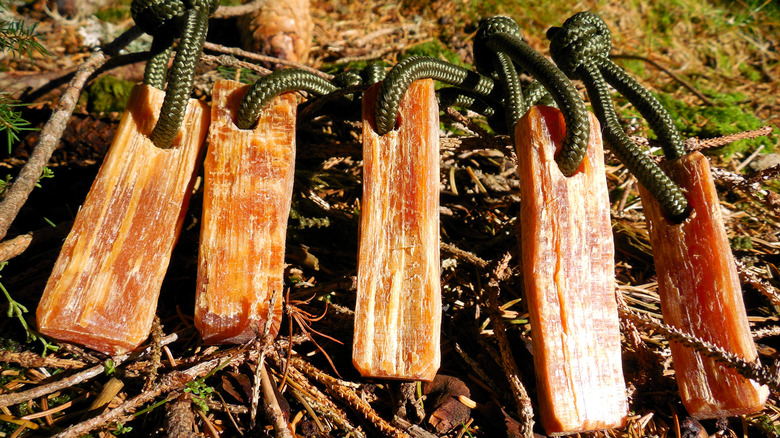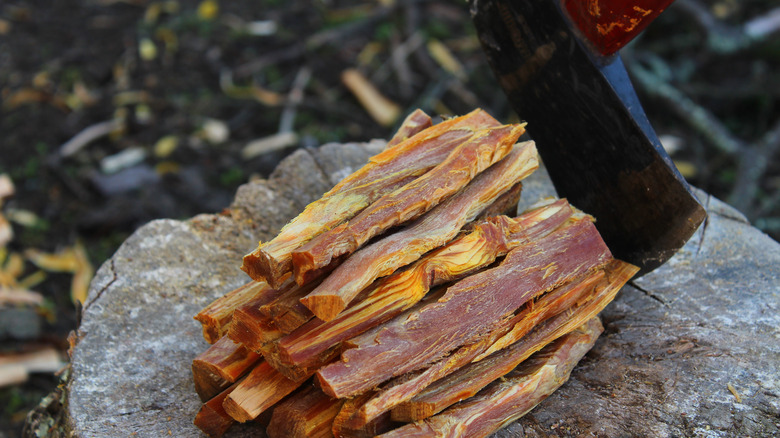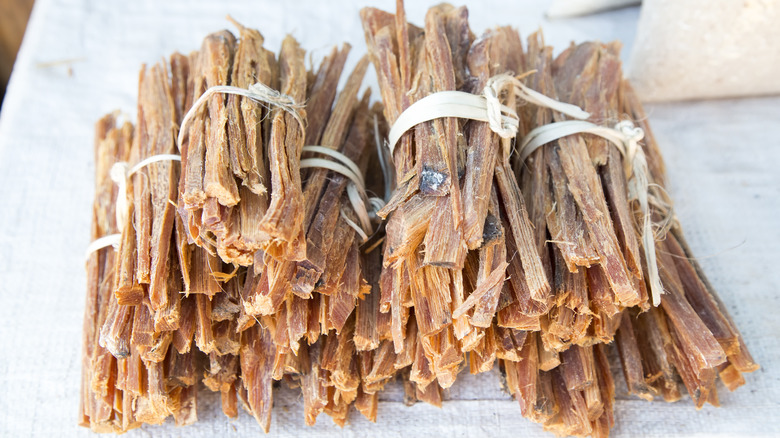The Chimney-Safe Secret To Getting Your Fireplace Going Fast
We may receive a commission on purchases made from links.
In some areas of the country, fatwood (also known as "fat lighter" and a half-dozen other names) has taken on almost mythic characteristics. Younger generations may know how wonderfully it works for starting a firewood, but have less need and fewer opportunities to track it down. Fatwood, the remains of a dead pine tree in which sap has concentrated in the heartwood, is generally considered the best natural firestarter. What once involved tromping through pine woods with a hatchet is now a matter of placing an Amazon order. By all accounts, modern fatwood is just as great as the stuff of memory, and probably less alarming to your suburban neighbors, who might look askance at someone prowling the woods by the neighborhood pool with a hatchet.
But it might be worth alarming your neighbors a little. Fatwood is 100% natural and non-toxic, and it doesn't contain chemicals other than pinewood and sap. It will light up even when wet, usually requiring nothing more than a single match. It burns hot enough that just a few sticks can get a campfire or wood stove roaring and leave very little residue behind. And it can be sustainably harvested by someone who isn't carrying a hatchet around your neighborhood green space. There are lots of good homemade firestarter ideas out there, but you won't find many as satisfying as this all-natural inferno instigator.
How to use fatwood
You can think of fatwood as super-kindling. Starting a fire with it is simply a matter of stacking two or three pieces and firing them up. Okay, it's a little more complicated than that, but not much. Stack your fatwood so that air can move around the pieces. It's always ideal to start a fire on a grate to provide extra room for oxygen at the base of the fire, but it's not necessary. Arrange your fuel wood on top of the fatwood, using more for a larger fire, and make sure to leave room around the fuel wood for airflow as well. The fatwood at the bottom should light as well as any tinder and burn hot enough to ignite collected firewood in a campfire, though it's always best to use split and properly dried firewood.
You might be concerned about burning what amounts to concentrated pine in your wood stove. Don't be. It turns out that the long-held claim about pine causing more creosote than hardwoods is a myth. Properly seasoned softwoods actually produce less creosote, and because you burn so little fatwood and it burns so hot and so completely, its contribution to creosote residue is negligible.
Where to get fatwood
You can get fatwood from any number of other online and brick-and-mortar retailers, such as Tractor Supply and Home Depot. We looked at pricing at a number of common sellers, and Tractor Supply had the lowest per-pound price at 2.25. Most other prices were within $.25 of Tractor Supply's.
Of course, there's also the old-school way of getting it, if you have access to and permission to take fatwood from some wooded property. A local arborist might be able to point you in the right direction to find fatwood and might also be a good source of free firewood near you. Any pine tree can produce fatwood, but the longleaf pine is most commonly associated with it. Look for a stump that has been dead long enough for the tree to have mostly rotted away. When you shave off the outer layer of the trunk with a hatchet or small axe, you should find yellowish, resinous wood underneath that smells strongly of pine or even of turpentine. Now comes the fun part. Once you're sure there's not a yellow jacket nest under the dead trunk, proceed to kick, wiggle, kick, push, kick, pull, and kick the stump until it releases itself from its rotted roots. Now you have a treasure to amaze your kids and grandkids, at least until they discover you can buy it at Lowe's without kicking anything at all.


